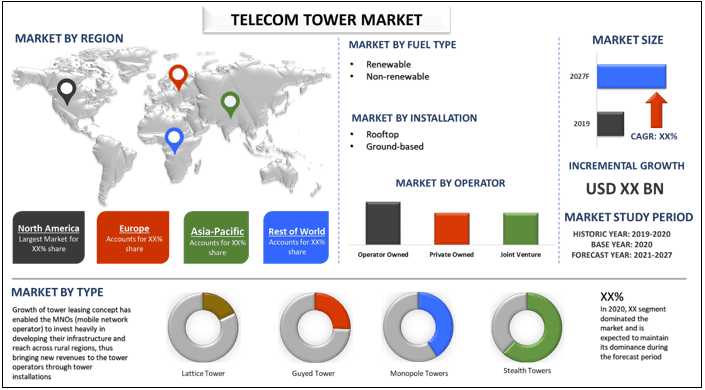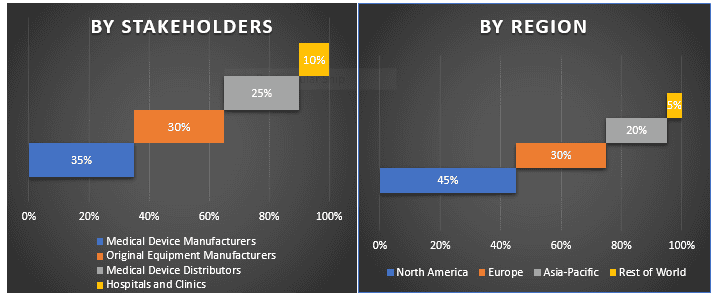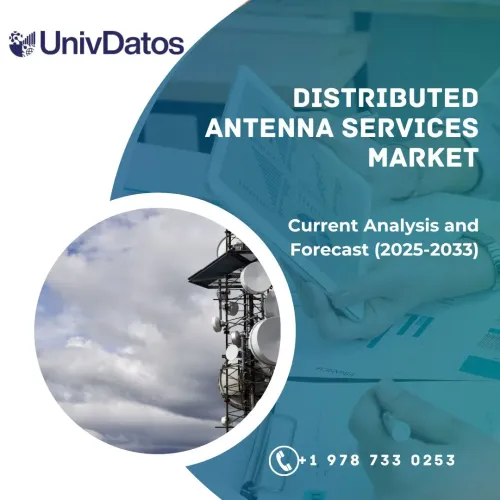- Home
- About Us
- Industry
- Services
- Reading
- Contact Us
Telecom Tower Market: Current Analysis and Forecast (2021-2027)
Emphasis on Type (Lattice Tower, Guyed Tower, Monopole Towers, Stealth Towers); Fuel Type (Renewable, Non-renewable); Installation (Rooftop, Ground-based), Operator (Operator Owned, Private Owned, Joint Venture); and Region and Country

The global telecom tower market was valued around $33 billion in 2020 and is expected to showcase single digit growth during the forecast period. With innovation at the core, the telecom tower industry has carved a global niche in infrastructure sharing. By focusing on the right mix of competencies and business opportunities, the tower industry is expected to drive the upcoming infrastructure revolution globally. Rising growth of data paired with the imminent launch of next generation 5G technology, the coming decade holds exciting new prospects for tower companies. Plenty of new opportunities are arising for tower companies to shift their attention from a macro tower focused business, towards new business models hinged on fiber, small cells, data centers, Wi-Fi, smart cities, and many. Telecom tower industry is a global affair, with number of different active independent tower companies operating in different regions. For instance, American Tower, Crown Castle and SBA Communications have been around for 20 years or more in the established US market. TowerXchange tracks 249, a tower infrastructure companies are estimated to collectively own around 70% of the world’s more than 4 million investible towers and rooftops. United Kingdom is hone to three main private independent players including Arqiva, Infrastructure Group and Cellnex, which collectively own about 35,000 towers. However, independently owned towers still only account for less than 20% of the European total.
Global Mobile User Estimate for 2021
During the Covid-19 pandemic, the global telecom sector has witnessed tremendous growth. Owing to the nationwide lockdown in many regions, the telecom industry has witnessed a significant growth in the overall demand for internet services as majority of the population were staying at home and remote working conditions. With the increase in people working from home has led to an increase in demand for downloading, online video viewing, and communication through video conferencing, all these factors have led to the increased network traffic and data usage in the early 2020.
Insights Presented in the Report
“Amongst Type, Lattice Tower segment dominated the market in 2020.”
Based on type the global Telecom Tower market is bifurcated into Lattice Tower, Guyed Tower, Monopole Towers, Stealth Towers. In 2020, Lattice Tower segment dominated the market and is expected to maintain its dominance during the forecast period. Growth of tower leasing concept has enabled the MNOs (mobile network operator) to invest heavily in developing their infrastructure and reach across rural regions, thus bringing new revenues to the tower operators through tower installations.
“Amongst fuel type, Non-renewable segment dominated the market in 2020.”
Based on fuel type, the market is segmented into Renewable, Non-renewable. Currently, Non-renewable fuel segment dominated the market. However, growing government initiative for alternative fuel sources is expected to drive the market for renewable fuel segment in the telecom tower sector.
“Amongst installation, Ground-based telecom tower segment dominates the market in 2020.”
Based on Installation, the market is bifurcated into Rooftop, Ground-based. In 2020, Ground-based telecom tower segment dominated the market and is expected to maintain its dominance. In March 2021, Helios Towers enters into partnership agreements with Airtel Africa Group companies for the acquisition and rollout of over 2,500 sites.
“Amongst operator, operator owned segment dominated the market in 2020.”
Based on operator, the market is bifurcated into operator owned, private owned, joint venture. Currently, operator owned segment dominated the market and is expected to maintain its dominance throughout the forecast period. In the Europe independent tower operator account for around 20% share in 2020.
“Asia-Pacific represents as the largest markets in the Global Telecom Tower Market.”
For a better understanding of the market adoption, report provide detailed analysis for major region and countries including North America (US, Canada, Rest of North America), Europe (Germany, UK, France, Spain, Rest of Europe), Asia-Pacific (China, Japan, India, Australia, Rest of APAC), and Rest of World. North America with countries such as US, Canada etc. are investing in upgrading the old telecom assets. Some of the major companies profiled in the report includes American Tower Corporation, Bharti Infratel Limited, Helios Towers Africa, SBA Communications Corporation, AT&T Inc., Tower Systems, Inc., GTL Infrastructure Limited, Indus Towers Ltd., Vertical Bridge, LLC., Orange.
Reasons to buy this report:
- The study includes market sizing and forecasting analysis validated by authenticated key industry experts
- The report presents a quick review of overall industry performance at one glance
- The report covers in-depth analysis of prominent industry peers with a primary focus on key business financials, product portfolio, expansion strategies, and recent developments
- Detailed examination of drivers, restraints, key trends, and opportunities prevailing in the industry
- The study comprehensively covers the market across different segments
- Deep dive country level analysis of the industry
Customization Options:
The Global Telecom Tower Market can further be customized as per the requirement or any other market segment. Besides this, UMI understands that you may have your own business needs, hence feel free to connect with us to get a report that completely suits your requirements.
Table of Content
Analyzing the historical market, estimation of the current market, and forecasting the future market of the Telecom Tower were the three major steps undertaken to create and analyze its adoption across the globe. Exhaustive secondary research was conducted to collect the historical market numbers and estimate the current market size. Secondly, to validate these insights, numerous findings and assumptions were taken into consideration. Moreover, exhaustive primary interviews were also conducted, with industry experts across the value chain of the Telecom Tower market. Post assumption and validation of market numbers through primary interviews, we employed a bottom-up approach to forecast the complete market size. Thereafter, market breakdown and data triangulation methods were adopted to estimate and analyze the market size of segments and sub-segments the industry pertains to. Detailed methodology is explained below:
Analysis of Historical Market Size
Step 1: In-Depth Study of Secondary Sources:
Detail secondary study was conducted to obtain the historical market size of the Telecom Tower market through company internal sources such as annual report & financial statements, performance presentations, press releases, etc., and external sources including journals, news & articles, government publications, competitor publications, sector reports, third-party database, and other credible publications.
Step 2: Market Segmentation:
After obtaining the historical market size of the Telecom Tower, we conducted a detailed secondary analysis to gather current market insights and share for different segments & sub-segments for major regions. Major segments included in the report are by type, fuel type, installation, and operator. Further regional and country-level analyses were conducted to evaluate the overall adoption of the Telecom Tower globally.
Step 3: Factor Analysis:
After acquiring the historical market size of different segments and sub-segments, we conducted a detailed factor analysis to estimate the current market size of Telecom Tower. Further, we conducted factor analysis using dependent and independent variables such as growing penetration of internet owing to increasing urban population and government initiative to use renewable fuel sources etc. A thorough analysis was conducted for demand and supply-side scenario considering top partnerships, merger and acquisition, business expansion, and product launches in the Telecom Tower industry.
Current Market Size Estimate & Forecast
Current Market Sizing: Based on actionable insights from the above 3 steps, we arrived at the current market size, key players in the Global Telecom Tower market, and market shares of each segment. All the required percentage shares split, and market breakdowns were determined using the above-mentioned secondary approach and were verified through primary interviews.
Estimation & Forecasting: For market estimation and forecast, weights were assigned to different factors including drivers & trends, restraints, and opportunities available for the stakeholders. After analyzing these factors, relevant forecasting techniques i.e., bottom-up approach was applied to arrive at the market forecast to 2027 for different segments and subsegments across the major regions globally. The research methodology adopted to estimate the market size encompasses:
- The industry’s market size, in terms of value (US$) and the adoption rate of Telecom Tower across the major markets
- All percentage shares, splits, and breakdowns of market segments and sub-segments
- Key players in the Telecom Tower market in terms of product and services offered. Also, the growth strategies adopted by these players to compete in the fast-growing market.
Market Size and Share Validation
Primary Research: In-depth interviews were conducted with the Key Opinion Leaders (KOLs) including Top Level Executives (CXO/VPs, Sales Head, Marketing Head, Operational Head, and Regional Head, Country Head, etc.) across major regions. Primary research findings were then summarized, and statistical analysis was performed to prove the stated hypothesis. Inputs from primary research were consolidated with secondary findings, hence turning information into actionable insights.
Split of Primary Participants in Different Regions
Market Engineering
Data triangulation technique was employed to complete the overall market estimation and to arrive at precise statistical numbers of each segment and sub-segment of the Global Telecom Tower market. Data was split into several segments & sub-segments post studying various parameters and trends in the areas of type, fuel type, installation, and operator.
The main objective of the Telecom Tower Market Study
The current & future market trends of Global Telecom Tower were pinpointed in the study. Investors can gain strategic insights to base their discretion for investments from the qualitative and quantitative analysis performed in the study. Current and future market trends would determine the overall attractiveness of the market at a country level, providing a platform for the industrial participant to exploit the untapped market to benefit as a first-mover advantage. Other quantitative goals of the studies include:
- Analyze the current and forecast market size of Telecom Tower in terms of value (US$). Also, analyze the current and forecast market size of different segments and sub-segments
- Segments in the study include areas of type, fuel type, installation, and operator
- Defined analysis of the regulatory framework for the Telecom Tower industry
- Analyze the value chain involved with the presence of various intermediaries, along with analyzing customer and competitor behaviors of the industry
- Analyze the current and forecast market size of the Telecom Tower for the major countries
- Major regions/countries analyzed in the report includes North America (US, Canada, Rest of North America), Europe (Germany, UK, France, Spain, Rest of Europe), Asia-Pacific (China, Japan, India, Australia, Rest of Asia-Pacific), and Rest of World
- Company profiles of the Telecom Tower market players and the growth strategies adopted by them to sustain in the fast-growing market
Deep dive country level analysis of the industry
Related Reports
Customers who bought this item also bought










